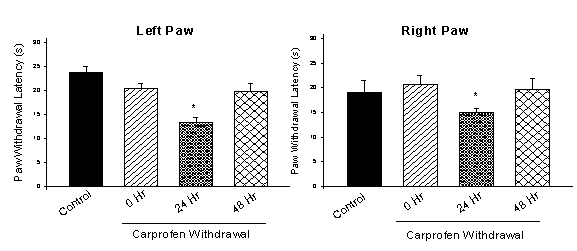| pA2 online © Copyright 2004 The British Pharmacological Society |
124P
University of Bath Summer Meeting July 2004 |
|
Cessation of carprofen treatment induces a hyperalgesic response 24 hours after discontinuation of treatment in rats Vanessa Vogel & William P. Watson, Department of Neuropharmacology, H. Lundbeck A/S, DK-2500, Valby, Denmark |
|
In an attempt to improve the ethical aspects of our animal models and minimise discomfort, we considered whether animals, which had received surgery for neuropathic pain studies, could be continually treated with analgesics until just before testing. In order to validate this idea, we explored the effect of long-term treatment with carprofen on behavioural tests of nociception in normal animals.
Four groups of 8 male Wistar rats (180-200g) were used. The Cox-2 inhibitor, carprofen ( 50 mg/ml Rimadyl®; 1:50 dilution; 10 mg/kg) was administered once daily (sc) for 7 days to 3 groups, whilst a final group (Control) received saline vehicle injections. The groups were “withdrawn” from carprofen treatment 0h, 24h or 48h prior to testing. The Plantar test (Hargreaves et. al., 1988) was used to assess nociception, by automatically measuring the reaction time of a rat to an infra-red (IR) heat stimulus. The animals were acclimatised to the test compartment for 5 -10 minutes. The IR source, at varying intensities (IR25; IR50 and IR75), was positioned directly beneath each hindpaw of the rat for a maximum of 30s. The movement of the paw in response to the heat switched off the IR source and stopped the reaction time counter. Data was analysed by two-way ANOVA followed by Dunnett’s test.
A significant hyperalgesic response was observed at IR25 (non-noxious pain stimulus) 24 hr after withdrawal from carprofen treatment (shortening of the latency to paw withdrawal) in both the left and the right hind-paws compared to control rats (figure 1). There were no significant differences at IR50 or IR75 (data not shown).
This study demonstrated that cessation of treatment with carprofen can adversely affect the behavioural end-points used in neuropathic pain studies. We have yet to assess whether such treatment would also affect the development of neuropathic pain in our models. We are not aware of previous studies examining withdrawal from this class of analgesic in rats. Finally, this “withdrawal” effect may have implications from an animal welfare perspective, for example if analgesic treatment is removed before an animal is fully recovered from post-operative pain.

Figure 1. Paw withdrawal latency (mean ± SEM; n=8) in the Plantar test at IR25 after 0, 24 and 48 h into cessation of carprofen treatment. * P < 0.05 compared to control.
Hargreaves, K. et al. (1988). Pain 32, 77-88